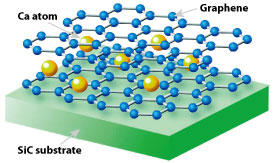

06/27/2016

© 2016 Takashi Takahashi
The first direct evidence of graphene acting as a superconductor has been reported by AIMR researchers1. This demonstration, which occurs at temperatures close to absolute zero, sets the stage for molecular-scale devices that can move electrons effortlessly and do not generate waste heat.
Ever since layers of graphene — one-atom-thick sheets of carbon atoms — were first isolated, researchers have been fascinated with the way electrons behave as near-massless particles when they move between its carbon atoms. This remarkable electron mobility has raised the exciting possibility of producing superconducting graphene, but unfortunately graphene has too few electrons to realize zero-resistance flow.
Now, Takashi Takahashi and colleagues from the AIMR at Tohoku University and the University of Tokyo have developed a method that boosts the electron density of graphene to the requisite levels for superconductivity. They grew two layers of graphene on top of silicon carbide and then sandwiched calcium atoms between the two graphene sheets to improve the material’s conductivity.
“Fabricating genuine bilayer graphene is challenging because other products, such as single- and tri-layer graphene, can form, and they complicate data analysis,” says Takahashi. To overcome this problem, the researchers performed their experiments in extremely clean, ultrahigh-vacuum environments and monitored graphene growth as it occurred. They found that optimizing the precise timing of temperature changes was critical for controlling the number of graphene layers.
Finding the best way to insert calcium into the bilayer graphene was just as vexing. Simple deposition techniques were unsuccessful, probably because calcium atoms are too large to squeeze into the sandwich. “Instead, we developed a special ‘atom-replacement’ method,” notes Takahashi. In this technique, smaller lithium atoms are deposited into bilayer graphene, thereby expanding the interlayer distance. Calcium atoms are then placed on top of the graphene, and they swap places with the sandwiched lithium atoms on heating (see image).
The researchers used a custom-made four-point probe to measure the calcium–graphene material inside the ultrahigh-vacuum chamber. When they gradually lowered the temperature to 4 kelvin, they saw the much-desired zero-resistance state. In contrast, pure bilayer graphene and the lithium-doped material showed no signs of superconductivity.
“We were all excited when we saw these experimental results,” says Takahashi. “They indicate that superconductivity is driven by charge transfer from the calcium atoms to the graphene sheets.”
The team is currently exploring using different graphene layer structures and metal atoms to raise the onset of superconductivity to more practical temperatures.
This research highlight has been approved by the authors of the original article and all information and data contained within has been provided by said authors.